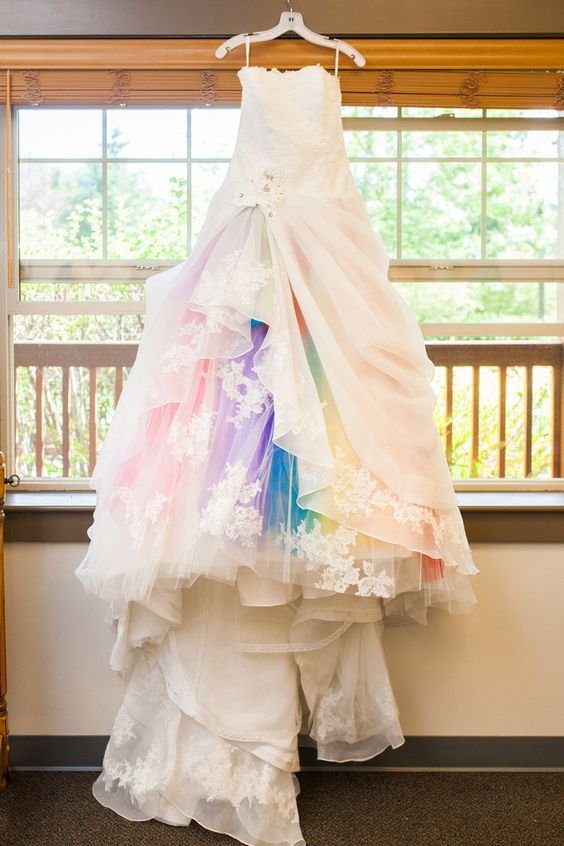How to Prepare, Care, & Dye Your Wedding Dress
A bride posing outdoors in a white ruffled wedding dress with dyed color layers. Image by Nava Durga Party Venue.
Looking for a bit more color in your life?
Believe it or not, your wedding dress doesn’t HAVE to be white. Sure, it may be traditional, but adding colorful elements allows you to put your own stamp on the dress for your wedding day or so you can reuse it in the future.
The most popular way to add color is to use dye. You can enlist a professional or do it yourself. It may sound scary, but it’s actually very doable, even with no previous experience!
Here’s everything you need to know before you dye your wedding dress.
Why Dye a Wedding Dress?
There are many reasons to dye a wedding dress. The biggest reason is personalization. Every bride wants to stand out. Adding color to your dream dress will create a showstopping garment that is unique and creative.
Another reason is to transform a second-hand or vintage dress. Some brides want to wear dresses that have been passed down or that they thrifted. Part of accessorizing their wedding dress is using dye.
This elevates the dress and allows you to put a unique stamp on the piece. You could also be looking to dye your original wedding dress for a vow renewal, so you’ll walk the aisle in your same dress, but the color will reflect the new chapter of your life!
Finally, some brides dye their wedding dresses to fit a wedding theme. You may want your dress to fit into your chosen color scheme or reflect a theme you’re really excited about.
For instance, if you’re planning a bohemian wedding, you may want to add some subtle color to the edges of your dress to add to the artistic vibe.
Choosing the Right Dye: Types and Brands
A beautiful ombre dyed wedding dress in various shares of purple to match the bride’s hair. Photo credit: Renegade Bridal.
There are lots of choices when it comes to dyes, so you need to do your research. Fabric dyes like Rit, Dharma, and Pro Chemical and Dye are great choices.
All of these brands have lines for specific fabric types, so you'll be able to find the right formula for your dress. You can also use natural dyes made from materials like purple cabbage and indigo if you’re looking to avoid harsh chemicals.
Fabric dyes are more likely to give you true, bold colors than natural dyes, which offer a more subtle hue. Always identify your dress fabric before you settle on a specific dye formula.
Preparing the Dress for Dyeing
Before you dip your dress, you’ll need to get your ducks in a row. Take the time to identify what fabrics make up your dress. Silk dresses take dye very well, but satin needs special dye to color evenly.
If there are lace embellishments, take note that they will absorb dye at a different rate than the rest of the dress. Remove any appliques or decorations from the dress. You can dye them separately and add the back on for the most expensive look.
Clean your dress well based on the manufacturer's instructions. Stains may be highlighted, depending on the color you’re using. Then, do a small swatch test.
You can cut a piece of fabric from the inside of the dress or apply the dye to an inconspicuous part to ensure it takes.
DIY Dyeing Process: Step-by-Step Guide
A bride wearing a white and yellow dyed wedding dress holding a goat outdoors.
Gather Materials
If you’re DIYing the dyeing process, gather all the materials you’ll need to dye your wedding dress. Here’s what you should have on hand:
Two or three bottles of dye, depending on the amount of fabric you need to dye
Rubber gloves
Tongs
A large stainless steel pot, large plastic bin, or utility sink
Water at the temperature required for the dye
Salt (if dying cotton)
White vinegar (if dying silk)
Measuring cups/teaspoon
2. Swatch Test Your Dye
Once you have everything, mix your dye and test it on a swatch to make sure it’s the color you want. Keep an eye on the clock to see how much time it takes to achieve the color you want.
That way, you know how long to leave your dress in the mixture for.
3. Apply the Dye to the Wedding Dress
Now it’s time to apply the dye! Starting with the hem, slowly place your dress into the dye. If you are coloring the whole dress, press the entire garment until it’s completely submerged.
If you are going for an ombre or dip dye effect, you’ll need to slowly lower it into the dye and secure the parts you want to remain white. Set a timer according to your test results.
4. Rinse Your Dress
When it’s time to rinse the dress, bring it to the bathtub to avoid staining surfaces. Wearing rubber gloves, rinse the dress under cold water until the water runs clear. This will prevent the dye from running onto other clothes and keep the color even.
5. Hang & Dry
Once rinsed, hang the dress and allow it to dry completely. Keep in mind the color may change as it dries. If it comes out too light, you can repeat the process.
Professional Vs. DIY Dyeing
If you’re nervous to DIY your dye job, you can enlist a professional. While it will cost a pretty penny, the pros will be able to analyze the makeup of your dress, choose the correct dye formula, and have lots of experience.
Do some research to find the best dyeing service for you. Read the reviews and look for pictures of their past work. Depending on your area and the season, it can take anywhere from one to three weeks to get your wedding dress dyed.
Most professional services will charge between $30 and $70 for a swatch test, which is totally worth it. A total gown dye job will cost around $1000. Ombre or dip dye service costs around $500. If you’re just looking to get your veil dyed, you can get that done for about $100.
Creative Dyeing Techniques
Dyeing your wedding dress is the perfect way to inject personality into the garment. If you still want some white or just want to add a little bit of color, there are some techniques you can use to create that perfect blend of traditional white and unique color,
Ombre/Gradient
Two ombre dyed wedding dresses inspired by the sunset. Photo Credit: Wai Ching Studios.
Ombre or gradient dying involves concentrating dye at one end of a dress and then allowing it to absorb and slowly fade into a paler color.
Decide where you want the lightest color to fall on the dress. Dip the entire dress until that point.
Then, submerge the dress about 6-12 inches from where you want the color to start deepening. Repeat the process until you get to the section that will have the most concentrated hue.
Allow the darkest part of your pattern to sit in the dye for the time recommended on the bottle. This will create a stunning effect.
Dip-Dyeing
A dip-dyed wedding dress on a bride inspired by galaxy shades. Photo credit: Demilked.
Dip-dyeing gives a two-tone, color-blocked effect when a garment is partially submerged into the dye bath while the remaining parts stay the original color.
It could use the same color blending techniques as ombre. But you’ll have a more stark contrast between the color of the dye and the original color of the dress.
Protect the undyed parts by wrapping them in plastic wrap to prevent accidental splashes.
Tie-Dye
The back of a hand-painted, tie dyed wedding dress as the bride walks down the aisle. Photo credit: Dionne Woods.
It’s not just for t-shirts! If you’re looking for a truly unique look, you can tie-dye or pattern-dye the dress!
There are lots of techniques you can research online, such as heart-shaped patterns and spirals, that will breathe life into your dress and create an unforgettable look.
Make sure this process, which uses rubber bands, is safe for your dress’s fabric type. You don’t want to leave unsightly dents and pulls that will distract from your beautiful work.
Color Inspiration: Popular Dye Choices
There are endless options for color. Choose what feels right to you. You’ll find dyes ranging from the brightest whites to the deepest hues, so go for something that fits your personality, style, and wedding theme.
If you want a show-stopping piece, go for bold hues like forest green, deep red, or sapphire blue. Want a more subtle dye job? Go for pastel versions of your favorite colors to create a subtle change in the dress.
The important thing is that you choose a color and pattern that speaks to you. After all, your big day is all about you, so go with the dye color and technique that make you feel beautiful.
Caring for a Dyed Wedding Dress
Maintaining your dyed wedding dress is nearly as important as dying it! When it’s freshly dyed, wear white cotton gloves to avoid leaving smudges or fingerprints on the dress. Hang it in a cool, dry space. Avoid direct sunlight that will fade your piece.
After wearing, wash the garment as little as possible. Spot clean stains with white vinegar. If you absolutely must wash it, opt for dry cleaning. Professionals will know how to maintain the color of a dyed dress.
When it’s time to store your gorgeous dress, keep it in a garment bag to avoid it rubbing up against other garments. The friction could lead to staining and wear.
Wrap the piece in acid-free paper as well. Don’t store it in plastic or in a humid space. Keep it in a dark, cool space in your home that’s climate-controlled to best preserve the color.
Considerations When Using Dye On a Wedding Dress
Of course, dyeing a wedding dress isn’t foolproof. Delicate fabrics or dresses made from multiple textiles can dye unevenly.
It’s also a challenge to dye large garments at home since not many households have vessels large enough to fit a voluminous dress. Also, dyeing garments in hot water may lead to shrinkage or puckering that could ruin the dress.
If you experience issues, like uneven dye, try running the garment or fabric through a cold, delicate cycle in your washing machine.
This may redistribute excess dye or remove enough to even out the color. You can also consult a professional dye shop for a price.
Alternatives to Dyeing
A stunning tiered wedding dress with a rainbow underskirt for a splash of color. Photo credit: Jason Comerford Photography.
If you want to add color to your dress but are apprehensive to dye it, there are lots of alternatives.
Accessories or Embellishments - You can add sparkle to your wedding dress with colorful accessories and embellishments. Since these are removable, they will preserve the integrity of your dress while giving it the personality you crave.
Fabric Paint or Markers - You can also use fabric paint or markers on specific areas of the garment. For example, you can draw a design along the hem in your color of choice.
Layering - Add a colorful veil or sheer skirt overlay, like what is typically done with gothic wedding dresses. You can also invest in colorful petticoats and underskirts for a pop of color as you walk down the aisle!
Wrapping Up the Dyeing Process
Dyeing your wedding dress can be scary. But with the right research and resources, you can transform your garment into the dress of your dreams.
Take your time, ask for advice, and follow your heart. At the end of the process, you’ll have a beautiful dress that reflects who you are!








